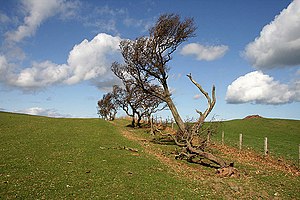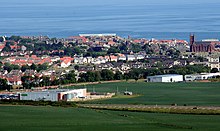Doon Hill, East Lothian: Difference between revisions
Created page with "{{Infobox hill |name=Doon Hill |county=East Lothian |range= |picture=Trees on Doon Hill - geograph.org.uk - 1777321.jpg |picture caption=On Doon Hill |os grid ref=NT68707553 |..." |
No edit summary |
||
| Line 23: | Line 23: | ||
[[File:Dunbar from Doon Hill - geograph.org.uk - 1344892.jpg|right|thumb|220px|Dunbar from Doon Hill]] | [[File:Dunbar from Doon Hill - geograph.org.uk - 1344892.jpg|right|thumb|220px|Dunbar from Doon Hill]] | ||
The site is now in the care of [[Historic Scotland]] | The site is now in the care of [[Historic Scotland]] | ||
==References== | |||
{{reflist}} | |||
[[Category:Prehistoric East Lothian]] | [[Category:Prehistoric East Lothian]] | ||
[[Category:Historic Scotland sites in East Lothian]] | [[Category:Historic Scotland sites in East Lothian]] | ||
Latest revision as of 11:10, 23 February 2019
| Doon Hill | |
| East Lothian | |
|---|---|
 On Doon Hill | |
| Summit: | 581 feet NT68707553 55°58’20"N, 2°30’48"W |
Doon Hill is a low hill near the coast of East Lothian, east of Spott, south of Dunbar. It is essentially just a subsidiary top of Brunt Hill (738 feet) whose summit is half a mile to the south, but Doon Hill is noteworthy as an important archaeological site.
On Doon Hill are the traces of two lordly hall, built on the same spot. Excavated by Dr Hope-Taylor from 1964-6 showed that two timber halls had stood successively on the same piece of ground, within a polygonal palisaded enclosure, of two corresponding structural phases. Before the construction of the halls, the site had been used as a cremation cemetery.
The later hall, 'Hall B' was recognised as an Anglo-Saxon lordly hall, in the typical rectangular style of that age. Its close resemblance in plan to the halls of the Oswald phase at Yeavering place it in the seventh century; those parts of the Yeavering site date from around 640 AD.
The earlier hall, 'Hall A' was destroyed by fire. Hall B was built within its foundations. Hall A though was in a different style, 75 feet long, divided internally by two rows of three vertical posts, so that it consisted of a large compartment in the middle with a smaller one at each end, and each gable wall in a very obtuse 'V' shape. It has been suggested that Hall A represents a native British style of architecture predating the English settlement.[1]
The cemetery is earlier: recent research puts it as having been occupied in the Neolithic era.

The site is now in the care of Historic Scotland